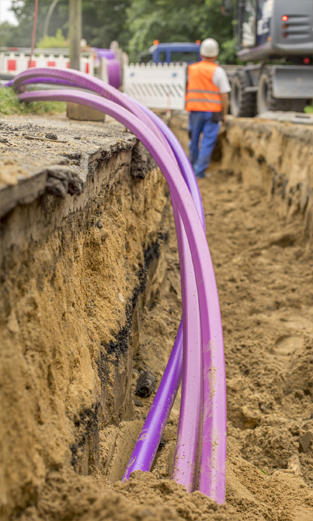The most modern definition of the term “Dark Fiber” refers to unlit (AKA: “dark”) fiber-optic cables that are already installed in the ground, and ready to be used, but which haven’t been taken advantage of yet. Why would unused fiber-optic cables be in the ground at all?
Rather than adding new strands of fiber-optic to an existing network, the Network Service Providers (NSPs) will often install more fiber than currently needed to fulfill their bandwidth requirements, with the idea that they can expand operations using the “Dark Fiber” cables in the future.
As such, these unlit fiber-optic lines represent an effort by the NSPs to save time, reduce cost, and future proof their networks against rising demand for higher bandwidth capacity.
 Installing extra fiber-optic cabling allows the NSPs to maximize their efficiency since the creation of a fiber-optic network involves a heavy investment of both time and money. Most of the planning that goes into a fiber-optic network revolves around determining the route of the cabling, but there are also other obstacles such as obtaining permission from local authorities for the construction of passageways and ducts for the fiber itself as well. It is only when the NSPs have obtained permission, constructed the passageways, and placed the fiber that every network element (i.e., switches, repeaters, etc.) can be connected together to provide internet connectivity.
Installing extra fiber-optic cabling allows the NSPs to maximize their efficiency since the creation of a fiber-optic network involves a heavy investment of both time and money. Most of the planning that goes into a fiber-optic network revolves around determining the route of the cabling, but there are also other obstacles such as obtaining permission from local authorities for the construction of passageways and ducts for the fiber itself as well. It is only when the NSPs have obtained permission, constructed the passageways, and placed the fiber that every network element (i.e., switches, repeaters, etc.) can be connected together to provide internet connectivity.
Thus, it only makes sense that the NSPs would try to install as much fiber-optic cable as they can once the ground has been broken, and as a result, there is an inordinate amount of dark fiber available in certain areas across the United States.
This availability, in conjunction with technologies such as dense wavelength division multiplexing (DWDM), has transformed dark fiber into a valuable asset and a highly sought after commodity for businesses, schools, and even for individuals who have very specific bandwidth needs.
When it comes to understanding dark fiber, there are a few important questions that we’ll need to cover first:
• Who is dark fiber for?
• What are the advantages of dark fiber?
• What are the disadvantages of dark fiber?
• How can you create your own dark fiber network?
Who is Dark Fiber for?
Dark fiber, in essence, can be purchased and operated by anyone who can afford the initial investment, but that doesn’t necessarily mean that this is a good idea, even if you want screaming fast internet. In general, dark fiber will only greatly benefit those organizations and businesses that have very specific network needs, and who also require end to end control of their network infrastructure.
Some businesses and organizations that can benefit from dark fiber:
• Manufacturing and logistical companies
• E-commerce and retail operations
• Hotels
• Government institutions
• Financial institutions
• College campuses & schools
• Internet providers and telecommunication companies
It’s easy to understand some of the benefits of dark fiber by looking at the example of a college campus. Most college campuses feature separate buildings for different departments, and oftentimes, these buildings need to be able to quickly communicate with one another for the purpose of transferring large data files.
For instance, Columbia College in Chicago deployed a dark fiber system throughout their campus, which allowed high-speed data transfers for film students; a population of students who regularly need to share very large files (gigabytes in size) between professors, peers, and others.
By connecting these buildings directly through a dark fiber-optic network, the school is now capable of supporting these high-speed data transfers in a reliable and secure fashion, which streamlines the process of transferring super large data files, making life much more convenient for film students.
Advantages of a Dark Fiber Network
 For most businesses and individuals, your local internet service provider (ISP) will typically have a bandwidth plan that is suitable for your network needs. There are some instances, however, where it makes financial and logistical sense for businesses, schools, and individuals alike to operate their own fiber-optic network, as shown in the example above.
For most businesses and individuals, your local internet service provider (ISP) will typically have a bandwidth plan that is suitable for your network needs. There are some instances, however, where it makes financial and logistical sense for businesses, schools, and individuals alike to operate their own fiber-optic network, as shown in the example above.
In short, dark fiber solutions make the most sense for businesses that not only need complete control of their network infrastructure, but also require near zero response times for point to point communication. With a dark fiber network, the operator can essentially act as their own ISP and avoid ever having to deal with service delays that can sometimes plague typical ISP to customer relationships.
Below are a few of the benefits that a dark fiber network can provide:
Scalability
Companies and businesses whose services and operations depend on high-speed bandwidth are perfect candidates for dark fiber network implementation, as it offers them some truly impressive benefits.
Growth is something that all businesses want; however, there are times when businesses might find themselves in a situation where their company is growing too fast. During times of rapid expansion, a company may discover that they simply don’t have the bandwidth to run their business in the most efficient and effective way possible. Running to an ISP for more bandwidth may not be the answer either, since the process of requesting more bandwidth may take weeks (or months, when construction is required), and would likely cost more in the long-run as well.
Once the initial investment in dark fiber has been made, all that is required by the company to increase its bandwidth capacity is to upgrade the equipment powering the fiber. While there is an investment to be made upfront, the company will now have access to near unlimited bandwidth and will not have to deal with additional monthly fees or service delays from the ISP.
Network Latency
Since running a dark fiber network requires the purchase and installation of your own transmission equipment, dark fiber customers have nearly limitless control over their network’s latency.
In some cases, if the connection points are close enough together, it might be possible to eliminate the transmission equipment altogether and simply connect the points directly through a router or some sort of network hub.
Having extremely low latency is crucial for companies who depend on fast communication between different point to point communications portals or between large data centers that need to communicate with each other quickly and seamlessly.
As an added benefit, since the dark fiber speed is controlled entirely by the owner of the lease, companies using the technology do not have to worry about sharing bandwidth with other customers as you would with a traditional ISP. This ensures the owner that they are getting 100% of the speed built into the fiber 100% percent of the time, so long as the equipment powering the fiber is working at full capacity.
Security
When it comes to security, dark fiber networks are about as secure as it gets. Because the dark fiber network itself is privately owned and operated by the lease owner, no other outside entities can track or record the data and information being transmitted through the fiber.
This level of security is crucial for all businesses and schools who have a need to transmit sensitive materials over a secure network on a constant basis, and is especially important for sensitive industries (like research, defense, financial services, etc.).
Reliability
Provided that the operators of a dark fiber network are equipped to handle the necessary repairs and maintenance, dark fiber networks offer a reliable, flexible, and high-speed bandwidth service that no ISP can match.
Normally, when you have a problem with your network, you have to send a request to the ISP for them to dispatch a technician who can investigate, identify, and solve the problem. The issue with this process is that the ISP is likely dealing with hundreds or even thousands of similar requests each and every day, meaning that it could be a while before they get around to dealing with your request.
On a dark fiber network, you don’t wait for anyone to help with issues, because you’re in complete control of the system and can resolve everything yourself. And in our modern world where internet connectivity is an absolute necessity, no business or school can afford to have downtime while waiting for the ISP to discharge repair people.
As an owner and operator of a dark fiber network, if there is a problem with the equipment, you can simply fix the equipment yourself without having to worry about getting in contact with an ISP to send out a technician. This allows you to minimize downtime if any problems should occur and help keep your business on track, and it’s especially important in industries where down-time truly will cost money.
Cost
While dark fiber pricing may be quite intimidating upfront, operators of a dark fiber network can rest assured that their costs for running the network are essentially fixed over the long-term.
When dealing with a traditional ISP, companies and businesses are always under the threat that the fees for their current level of service can go up over time, or that the service itself could even disappear entirely. This can end up costing companies more than what they would’ve paid for a dark fiber network, which is a huge problem considering that traditional bandwidth offerings cannot match the flexibility and scalability of operating your own fiber network.
Disadvantages of a Dark Fiber Network
While there are many advantages of operating a dark fiber network, there are some issues that need to be addressed before committing to invest in the infrastructure.
Upfront Investments
Before a company or other entity can establish their own dark fiber network, a dark fiber lease must first be established between the customer and the telecommunications provider. Once that lease is established, the equipment that powers the fiber must be purchased and installed before any sort of data can be transmitted through the network.
As far as pricing goes, costs can vary greatly from one location to the next. For example, Palo Alto Utilities offers dark fiber at a per month, per mile rate ranging from $213 to $425 for the first strand of fiber, whereas other local public utilities require an upfront licensing fee of $5,000 in addition to a $2,000 annual fee.
Depending on your bandwidth needs, you can also expect to spend an additional $5,000 to $10,000 for the equipment needed to power the fiber. It must be noted as well, that in order to upgrade your dark fiber’s network capacity, the equipment will have to be swapped out and upgraded which will be an additional cost.
Dark Fiber Availability
When it comes to setting up a dark fiber network, the issue of availability also arises. While it’s true that some areas across the United States have large networks of usable dark fiber waiting to be claimed, not every city has dark fiber available. Before moving forward with your network plans, it would be wise to get in contact with your local dark fiber providers or telecommunication companies to find out what’s available.
Maintenance and Repair
While it can be financially advantageous to operate a working dark fiber network, it is possible to run into trouble if things that your technicians can’t manage go wrong. When it comes to significant repairs, costs can quickly accumulate.
As such, maintaining a dark fiber network is an additional cost that must be considered, as the owner will need to monitor all aspects of the network to ensure that if a problem should arise (i.e., fiber cuts, routing problems, etc.) that it can be dealt with as soon as possible to minimize any downtime.
The Future of Dark Fiber
As the world comes to rely more heavily on internet connectivity for daily tasks and operations, and as telecommunications providers look for ways to expand their available bandwidth, dark fiber networks represent a great opportunity, at least under certain circumstances.
If you’re in a position to set up or manage the network of a company or organization, dark fiber is definitely a network solution to consider, as the benefits are too plentiful to ignore.

